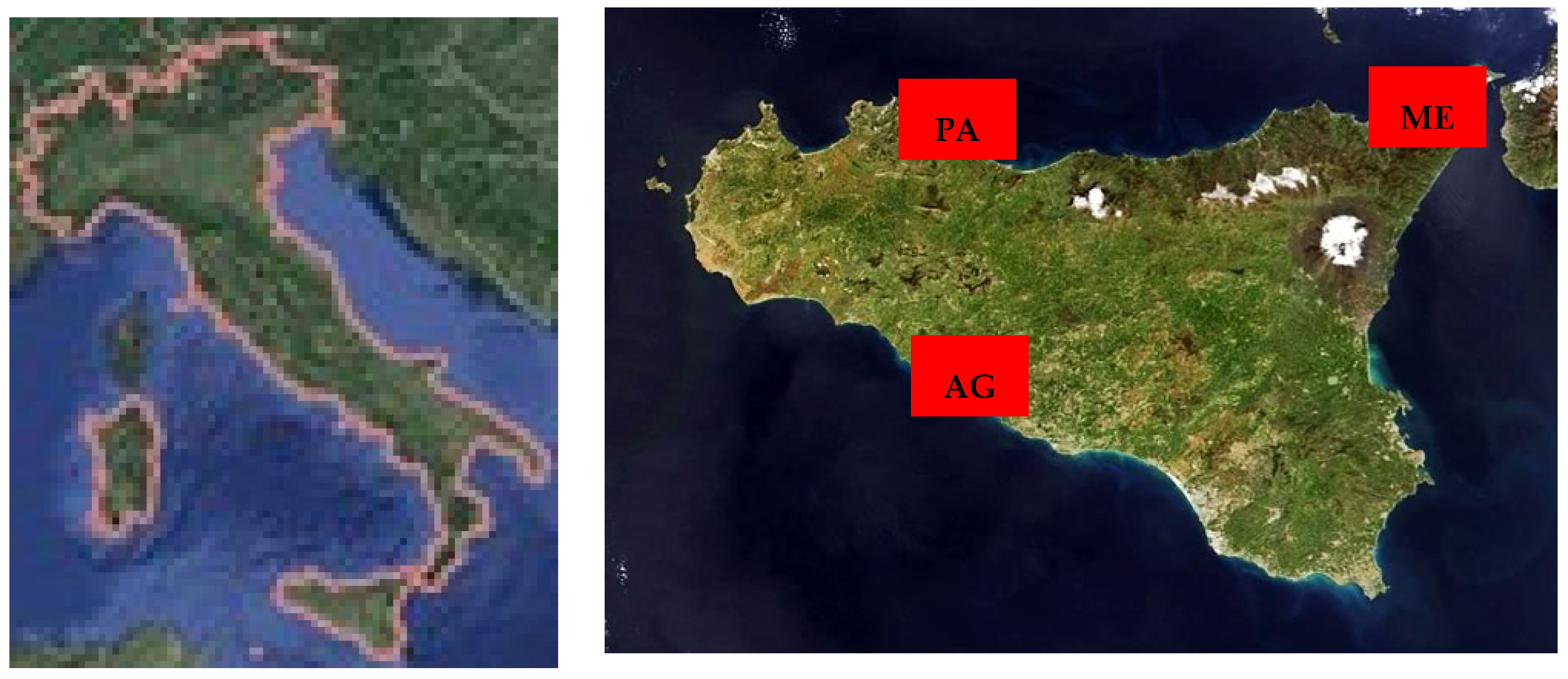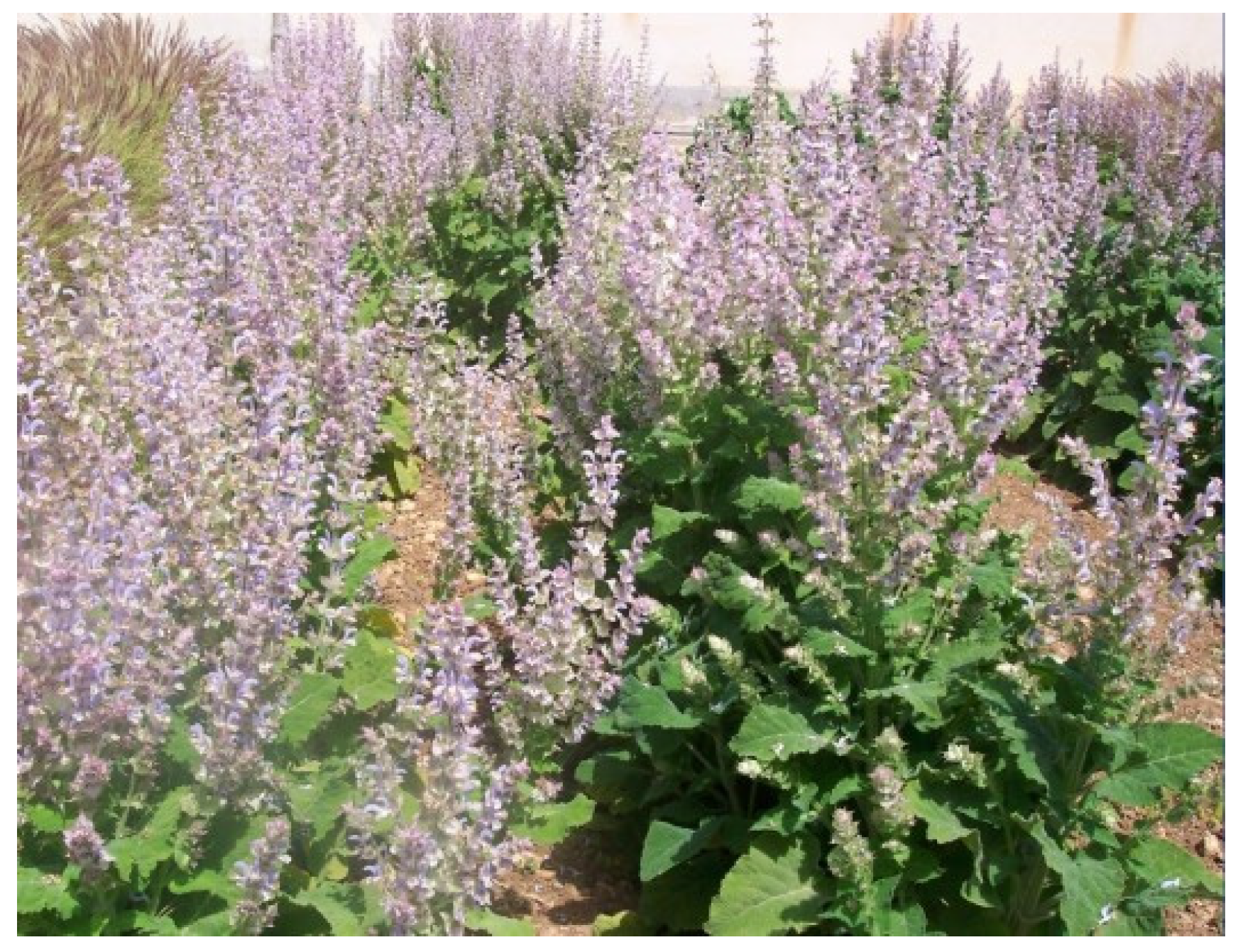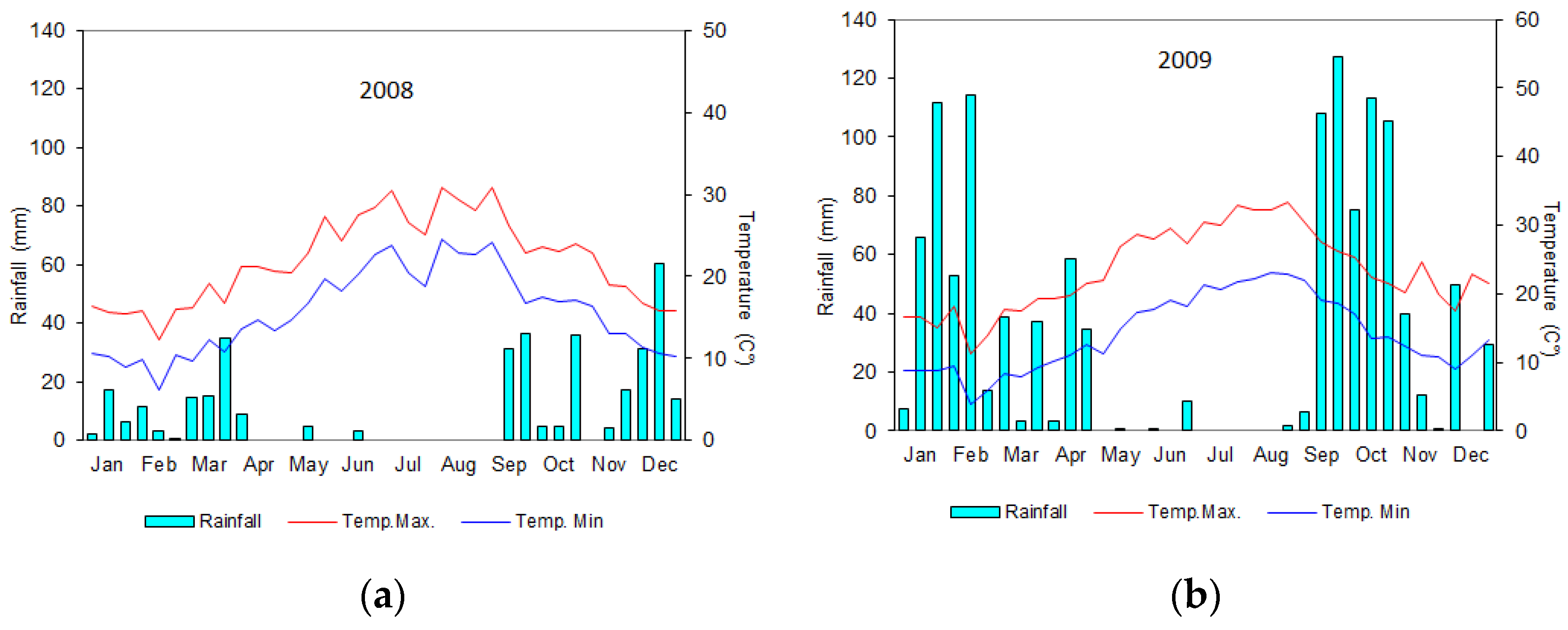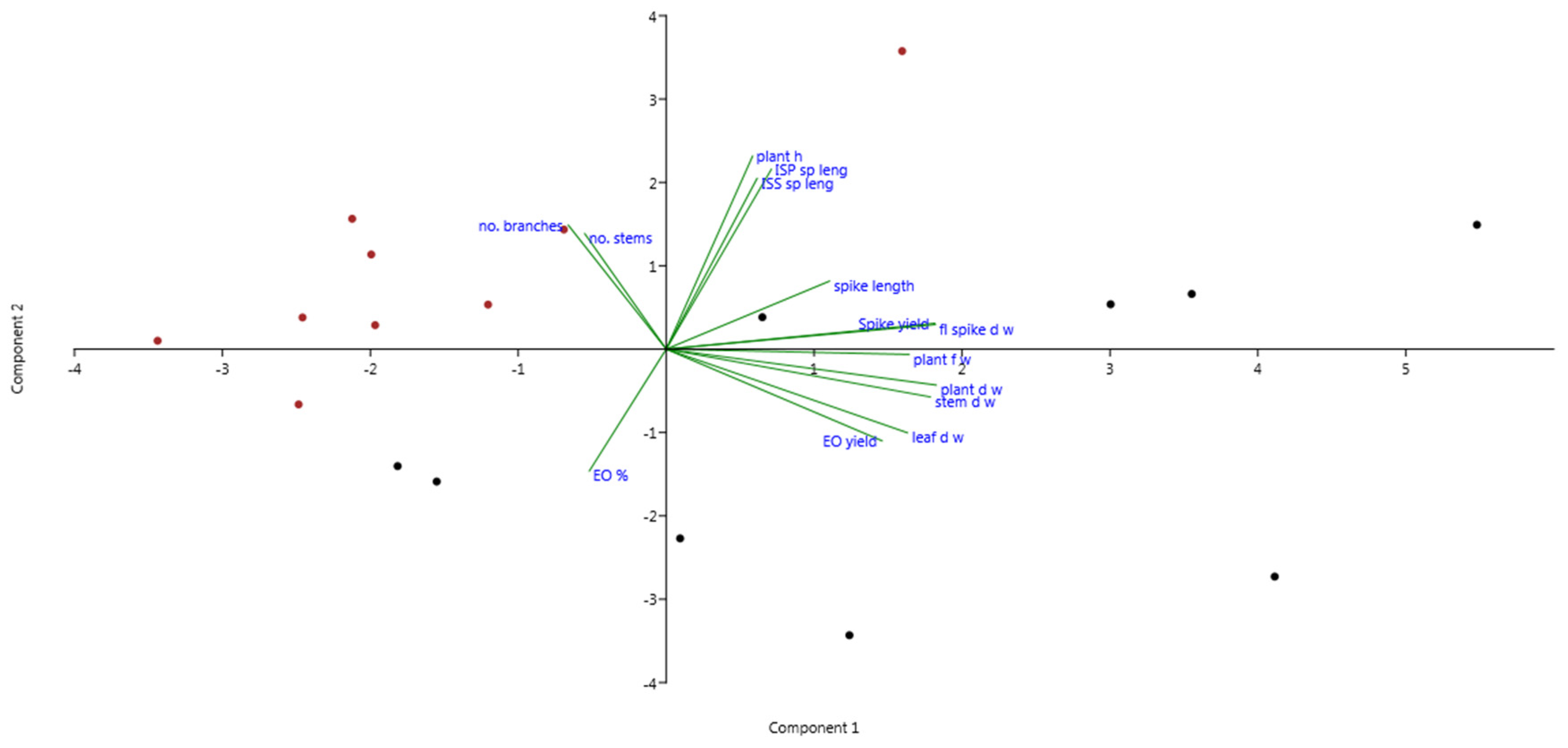3.2. Analyses of Biometric and Production Parameters in the Study
The factors “year” and “accession” and the year-by-accession interaction determined highly significant differences for all the parameters in the study. The differences found on the tested parameters over the years (
Table 2) highlight the influence of the environmental factors on the biometric and productive characteristics.
It is also worth noting variations in the percentage ratio of inflorescences, leaves, and stems for the two years under consideration (
Table 3). The table shows that in the drier year (2010), inflorescence incidence was 8 percentage points higher than the year with greater rainfall. In contrast, leaf incidence and stem incidence were 3 and 5 percentage points higher, respectively, in the rainier year than in 2010.
Average plant height (
Table 2) was found to be below 150 cm in both years. Branch number, stem number per plant, and ISS floral spike length were higher in the less rainy year. Floral spike yields were higher in 2009 (2.84 Mg ha
−1) than in 2010 (1.60 Mg ha
−1) with a difference of 1.24 Mg ha
−1. Essential oil content in percentage terms was slightly higher in 2010, while in terms of EO yield, it was found to be 9.10 kg ha
−1 higher in 2009 (23.51 kg ha
−1) (
Table 4).
Relative to the 2 types of floral spike (ISP and ISS), average ISS spike lengths ranged between 46.41 cm in 2009 and 50.76 cm in 2010, while ISP spike lengths were found to be around 58 cm in both years Furthermore, they showed significant differences over the two years, highlighting a greater oil percentage content in 2010 (
Table 5).
Between the accessions (
Table 6), SS4 (3.21 Mg ha
−1), SS7 (2.60 Mg ha
−1), SS9 (2.52 Mg ha
−1) and AF2 (2.53 Mg ha
−1) were of high interest regarding to the floral spike yield. These accessions also recorded the higher values of the number of stems, number of branches, and ISS spike length. PR5 (1.52 Mg ha
−1) and AF8 (1.63 Mg ha
−1) were, instead, the less productive accessions. The highest oil percentage values were obtained by AF8 (1.36%), AF3 (1.28%) and AF2 (1.25%), while the lowest values of oil percentage were found in the SS accessions and, in particular, in SS7 (0.65%). The higher oil yield values were recorded by AF2 (28.05 Mg ha
−1) and AF3 (25.10 Mg ha
−1) with respect to other accessions. AF8 had the highest oil percentage value in the ISS (1.68%), while PR4 obtained the highest oil percentage value in the ISP (1.12%).
Considering the results of accessions in the study, during the years 2009 and 2010 (
Table 7a,b), the best production results for 2009 were found in the Agrigento accessions (SS), followed by those of Messina (AF).
The best accessions, as regards inflorescence yields, were found to be SS4 and SS7 with 4.81 and 4.20 Mg ha−1, respectively. Worthy of note among the Messina accessions was AF2 which, compared to other accessions from the same area, produced higher yields of 3.41 Mg ha−1. This value was the minimum yield obtained by the Agrigento accession SS9 and above the average for the field (2.84 Mg ha−1). Regarding the Palermo (PR) accessions, with the exception of PR4 with a yield of 2.43 Mg ha−1, the remaining accessions produced inflorescence yields of approx. 1.50 Mg ha−1, thus appearing the least productive of the accessions.
The greatest plant height was obtained by SS4 (151.50 cm), higher than all the others in that year. This was followed by PR4 (142.00 cm) and SS9 (141.52 cm), while the shortest plant size was that of PR5 and AF3 at a height of below 130 cm. Relating to the fresh and dry weight of the plants, it is worth noting that all of the Palermo accessions (PR) were found to be well below the average for the field (2.84 Mg ha−1), together with AF8 from Messina, albeit to a far lesser extent. The number of branches, number of stems and secondary floral spike length were found to be higher in the SS and AF accessions, in particular in the more productive accessions. SS4 (12.01) and SS7 (12.51) were of interest regarding the number of branches, AF2 (4.52) regarding the number of stems and, concerning the secondary floral spike length (ISS), accession SS4 (60.06) was worthy of note. Average floral spike length together with that of the ISP was greater in the SS and PR accessions, with PR4 obtaining the greatest values.
The highest percentage content in oil was found in the AF accessions followed by those from Palermo and the lowest content was found in the SS accessions SS. In terms of oil yields, however, the most productive were the Messina accessions (AF2 38.41 kg ha−1), followed by the Agrigento accessions.
In the second year, there was a fall in production which altered the ranking of the accessions based on results in the study. More specifically, in 2010, similar to the first year, the Messina accessions were ranked as the most productive. The Palermo accessions, in contrast to the previous year, were also ranked at the top of the list. The above-mentioned areas of provenance were found to perform better than the Agrigento accessions not only in terms of average inflorescence yields but of all the other parameters examined. However, if we look at the Agrigento data more closely, regarding inflorescence yields, we can see that two of the three accessions, SS4 and SS9, produced values equal to the average for the field (1.60 Mg ha−1), only SS7 producing far lower yields (1.00 Mg ha−1). The AF accessions were ranked second. Of the three accessions, AF2 (1.61 Mg ha−1) and AF3 (1.83 Mg ha−1) produced inflorescence yields which were respectively equal or slightly higher than the average for the fields, while AF8 (1.41 Mg ha−1) was a little lower. Accession PR1 bolstered the results for the PR accessions with inflorescence yields of 2.81 Mg ha−1; 1.20 Mg ha−1 higher than the average for the field. In contrast, the other Palermo accession, PR4 and PR5 produced yields slightly below the average for the field.
Once again, PR1 obtained the highest plant fresh weight (1346.88 g) and dry weight (318.72 g), in addition to the highest inflorescence dry weight (139.64 g) and leaf dry weight (80.56 g). The greatest plant size was also obtained by PR1 (159.75 cm), statistically different from all the other plants. PR1 was followed by AF3 (152 cm) and AF2 (150.5 cm), while AF8 produced the smallest size plant (129.75 cm). In 2010, the greatest number of branches, number of stems, and floral spike lengths were obtained from the most productive accessions in the various areas. Regarding the number of branches, AF8 (19.75), AF3 (18.77) and SS9 (19.55) were worthy of note, as was AF2 (7.52) concerning the number of stems. The greatest main floral spike (ISP) and secondary spike (ISS) lengths were obtained from the Palermo accession PR1 at 72.75 cm and 57.40 cm, respectively. Concerning the percentage content of oil, in the second year, a general increase in production was evident in all of the accessions belonging to the Messina group and the Agrigento group, whereas a slight decrease was recorded in the remaining accessions; the ranking list remained unchanged, however, compared to the previous year.
In addition to the AF accessions, having a range between 1.23% (AF2) and 1.42% (AF8), other productive accessions were PR4 (1.10%), PR5 (0.99%) and SS4 (0.83%). In terms of oil yield, however, the most productive accessions were those belonging to the Messina group (17.70–21.10 kg ha−1) followed by PR1 (17.10 kg ha−1). The lowest values were, instead, achieved by SS7 (6.80 kg ha−1). Furthermore, values slightly higher than 10 kg ha−1 were found in other accessions.
Of interest here are average EO yields of the Agrigento accessions. EO yields in 2009 were 22.20 kg ha−1, decreasing to approx. 10.00 kg ha−1 the following year. This year witnessed a general fall in accession production. The Palermo accessions, however, maintained average EO yields of approx. 14.00 kg ha−1 during both years, due to the production performance of PR4 in 2009 and PR1 in 2010. The above-mentioned variations, as is generally known, can be attributed to several factors, including environmental and genetic differences.
3.4. PCA Analysis
PCA analysis was carried out to provide an overall assessment of the accessions over the 2 years and showed that the 2 biggest principal components accounted for 71.00% of total variability, rising to over 86.00% with the 3rd component (
Table 9). For analytical purposes, however, only the first two were considered of interest.
In
Table 10, it is clear that the biggest principal component (PC1), accounting for 49.20%, was strongly and directly correlated with as many as 7 characteristics out of the 14. In particular, it is associated with floral spike yield, essential oil yield, fresh and dry weight of the plant, and the dry weight of the inflorescences, leaves, and stems.
The second component, accounting for 22.00% of total variation, is strongly linked to the biometric characteristics, such as plant size, main floral spike length (ISP) and secondary floral spike length (ISS). Less marked, however, was the correlation found with two other biometric properties: branch no. and stem no., and inversely correlated, with the same intensity, with % content of EO.
Figure 4 shows a loading plot of the factor weights pertaining to the main two principal components.
From
Figure 5, which projects the distribution and clustering of the accessions on the plot for the two principal components, statistical data can be extracted.
In general, allocation of the accessions led to the identification of 2 clusters which corresponded to the two years. To the right of the origin are the accessions grown during the first year and to the left those grown during the second year. Hence, variations along PC1 can represent environmental variability during the two test years. Characteristics linked to this variability are those which are most affected by the factor “year”. However, several heterogeneities emerge which can be attributed to the Palermo accessions. More specifically, PR1 from 2010, allocated in the upper right quadrant, and PR1 and PR5 from 2009, in the lower left quadrant, diverge from this trend. Cluster analysis carried out led to the creation of 4 main groups: 3 for the first year and 1 for the second year. Relative to the first year (2009), each of the 3 main groups was formed by accessions from the same area of provenance. The exception to this concerned the Agrigento accessions, which also included the Palermo accession PR1 from 2010. These Agrigento accessions, however, when associated with the various production parameters, formed a subgroup which is in the upper right quadrant. This is an area which corresponds to high values for the first principal component; accession SS4 being of particular note. PR4, belonging to the other main group from the first year, is located in the same quadrant, though slightly more to the left. PR4, in contrast to other accessions from the same area (PR1 and PR5) managed to ensure a positive production outcome, although in a somewhat more contained manner. PR1 and PR5 formed a subgroup in the lower left quadrant in an area with negative values from both PC2 and PC1. The remaining group from this year, the Messina accessions (AF), are all located in the lower right quadrant, thus possessing negative values from the second principal component. As this is strongly correlated with plant height, ISP lengths and ISS length directly, and moderately correlated with percentage content of EO inversely, these accessions are small in size with a short floral spike but have a high % content of EO. Accession AF3 and, in particular, AF8 (lying near the axis of the second principal component) are more defined by PC2 compared to AF2. This latter is separate from the first two, forming a separate subgroup. In 2010, cluster analysis highlighted one main group with 2 subgroups: 1 of which containing 70.00% of the accessions and the other subgroup containing only AF3 and AF2. These latter were located to the left of the origin, and, therefore, with negative PC1 values. In general, relating to 2010, a more uniform distribution is apparent from the new positions occupied by the accessions, except for PR1. The position of this latter, as previously mentioned, is peculiar, given its position in a cluster located in the upper right quadrant and, thus, far from the main distribution for that year. For most of the accessions, small variations in position concern those along the PC1 axis, except for SS7. This accession was most affected, in production terms, by the environment. However, greater variations were found along the PC2 axis; in particular, in the area with high values concerning morphological characteristics. Several accessions, although occupying similar positions along the PC1 axis, obtained different yields and were mainly defined by those parameters directly linked to PC2. This was also true of accession AF8. Although it located in the lower left quadrant (the only accession in the subgroup located below PC1), it was the one with a greater percentage content in EO, as this parameter was inversely correlated with PC2. Nearer to the origin but positioned in the upper left quadrant, are AF2 and AF3. In this subgroup, AF3, which lies above AF2 along the PC2 axis, obtained production values which were even higher than the average for the field.













